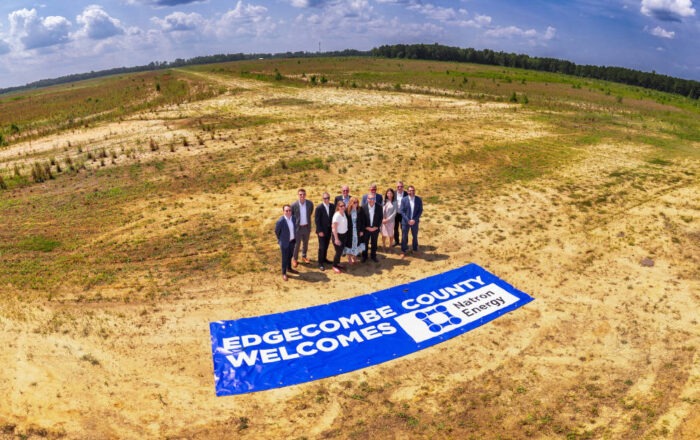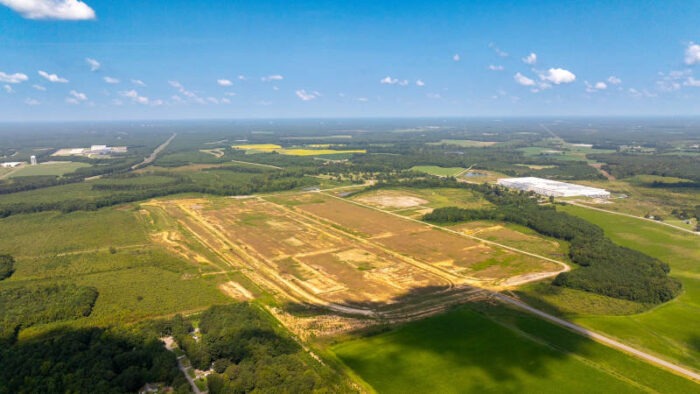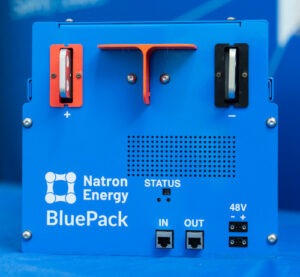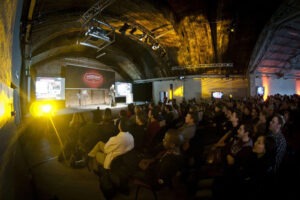Natron Energy’s sodium-ion batteries are non-flammable and have more energy density than lithium-ion batteries. Right now, they’re primarily being used as emergency backup in data centers, but expect to see them powering EVs soon.

Natron Energy, a twelve-year-old venture capital-backed company that designs and manufactures sodium-ion batteries primarily used by data centers, announced last week that it plans to spend $1.4 billion to construct a giga-scale sodium-ion battery manufacturing facility in North Carolina.
In April, the company built the first commercial-scale sodium-ion battery facility in the US in Holland, Michigan, which produces batteries totaling 600MW annually. When completed, the North Carolina facility is expected to produce 24GW of batteries annually.
“Today is a momentous day for Natron Energy,” the company’s founder and co-CEO, Colin Wessells, said in a statement. “This flagship manufacturing facility will dramatically accelerate our efforts to deliver sodium-ion batteries to customers who are hungry for safe, reliable, and environmentally responsible energy storage solutions.”
The facility will be located at the Kingsboro CSX Select Megasite in Edgecombe County in Eastern North Carolina near the city of Rocky Mount. Wessells said the site was chosen after evaluating more than 70 locations in nine states.
“We found that North Carolina, with its leadership in the clean energy revolution, would make the perfect home for this project,” he said. “We are proud to partner with the state on this ambitious project to deliver high-quality jobs to the community while advancing the electrification of our economy.”
That partnership will see North Carolina providing Natron with a Job Development Investment Grant of up to $21.75 million, along with incentives of about $40 million through the North Carolina Megasite Readiness Program. The planned 1.2 million-sqare foot facility will create 1,000 jobs.
Although nearly all of Natron’s batteries are currently data center bound — used to keep data centers operational during the crucial few minutes between the start of a grid-based power failure and the time it takes to get backup generators started and running — the company says it plans to expand into other markets when the new facility is operational.

Last weeks announcement comes on the heels of other battery manufacturers investing in North Carolina, which has lately been touting itself as a “Battery Belt” manufacturing hub. In May, 2023, Toyota announced that it was spending $2.1 billion to a build plant in the state to produce batteries for it’s hybrid and fully electric vehicles. In November Dai Nippon Printing announced that it was investing $233 million to build a facility to produce lithium-ion battery pouches. There are others opening facilities in the state as well, including Forge Nano and VinFast.
In addition, at least two mining companies — Albemarle Corporation and Piedmont Lithium — are attempting to exploit lithium deposits in the mountains west of Charlotte. If they’re successful they won’t be able to court Natron as a potential customer, however. It’s sworn off Lithium in favor of much more plentiful sodium.
Sodium-Ion: The New ‘Old Technology’
If you’ve never heard of sodium-ion batteries, don’t feel like the Lone Ranger. The technology hasn’t become buzz worthy yet, but doubtlessly it will.
The technology behind the batteries is similar to that of lithium-ion batteries. To oversimplify, lithium is replaced by sodium, which belongs to the same group in the periodic table as lithium and which has similar chemical properties. Commercial interest sodium-based batteries started to take hold in the 2010s and early 2020s, driven in part by lithium’s high cost. Another factor is that most sodium-ion batteries — including Natron’s — don’t require the use of cobalt, copper, or nickel, but use more abundant iron-based materials.
Here in the States, this means that the materials needed to manufacture the batteries can be sourced domestically, and without the environmental and human costs associate with lithium mining.
Another advantage is that sodium-ion batteries are naturally non-flammable, an issue that has been especially problematic with lithium-powered electric bicycles, which have been identified as the cause in a number of apartment building fires in urban areas.
There are drawbacks to the sodium-ion technology however, which is why you’re not yet running sodium-ion batteries in your phone and why they’re not yet powering your eccentric rich uncle’s EV. The biggest problem has been their relatively low energy density, meaning bulkier batteries that weigh more than comparable lithium-based batteries — which has been a big roadblock to the batteries being adopted to power EVs and hybrid vehicles.
That’s all about to change, according to Natron. It says it’s solved that stumbling block, and claims its sodium-ion batteries not only have more energy density than lithium-ion batteries but have quicker recharge times as well. In fact, the company claims that once its new factory is operational it will expand its offerings to include batteries for EVs and other devices.

Both the increased energy density and faster recharge times are likely due to the company’s secret sauce, which takes advantage of “Prussian blue,” a substance that’s been used commercially as a pigment in oil paints and other products for centuries, and when used in sodium batteries doesn’t expand and contract as it charges and discharges sodium ions.
“This ‘zero strain’ mechanism results in greater chemical stability and avoids the particle degradation that limits cycle life in other batteries,” Natron said in a downloadable PDF that explains it’s technology.
The technology also creates batteries with specs that are something of a perfect fit for data centers, which generally use battery-backup for only a couple of minutes after a power failure. The company says that its BluePack batteries produce 100% of their rated power over a two-minute discharge period, and more than 100% when operated for less than two minutes.
“It can also be rapidly recharged and is available immediately and without need for any thermal settling or cooling,” the company said in a statement. “This is contrasted to numerous lithium and nickel-zinc battery chemistries that require significant cooling time, require active cooling systems fraught with single points of failure, and decrease reliability in a critical power battery system.”
Christine Hall has been a journalist since 1971. In 2001, she began writing a weekly consumer computer column and started covering Linux and FOSS in 2002 after making the switch to GNU/Linux. Follow her on Twitter: @BrideOfLinux








Sodium ions have always been tempting since they supply the same single electron per atom and are obscenely common compared to Lithium. However they are about three times as heavy and 25% larger in radius which suggests heavier, larger batteries. Still, their chemistry while similar to Lithium is different and apparently the runaway discharge which threatens Lithium batteries is less likely with Sodium. Prussian Blue is an ancient pigment made from iron. It’s manganese analog has been put forward as a candidate electrode material for batteries for the last several years. The iron compound is so stable that it is even used medicinally internally but I don’t know about the toxicity of the Manganese analog, though it is probably fairly safe also. Manganese, while not as common as Iron, is still not particularly rare, being roughly 50 times more abundant than Lithium in the earth’s crust.
As an e-bike rider, I am of course intensely interested in whether these batteries will actually be available for my vehicle by the time I am ready to replace my present ride. Any idea, Chris?